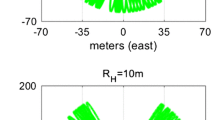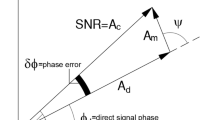Abstract
Exploiting the reflected signals from the surface of the Earth to provide information about the reflecting surface is the primary concept of GNSS Interferometric Reflectometry (GNSS-IR). One of the most common usages of GNSS-IR is the estimation of the absolute vertical distance from a GNSS antenna to the reflective surface. In this work, the authors present a developed MATLAB-based GNSS software, namely, GNSS-IR-UT that translates the various signal from different systems such as GPS (L1, L2 and L5), GLONASS (G1, G2 and G3), Galileo (E1, E5a, E5b, E5 and E6), and BeiDou (B1, B2 and B3), more precisely the signal-to-noise ratio (SNR) data, into the reflection height. This user-friendly software permits users to evaluate a variety of processing options and parameters in height calculation by taking advantage of the Graphic User Interface (GUI) of MATLAB. In this software, to extract the dominant frequency in reflectometry concept, the Least Square Harmonic Estimation (LS-HE) has been used for the first time. Moreover, besides the reflectometry applications, the users can use some parts of this software in working with GNSS data for their specific usage. All in all, we aimed at providing a new, easy to use, and powerful software to the scientific community to make it easy for new users of the GNSS-IR concept.













Similar content being viewed by others
Reference
Amiri-Simkooei A (2007) Least-squares variance component estimation: theory and GPS applications. Ph.D. thesis, Mathematical Geodesy and Positioning, Faculty of Aerospace Engineering, Delft University of Technology, Delft
Amiri-Simkooei AR, Zaminpardaz S, Sharifi MA (2014) Extracting tidal frequencies using multivariate harmonicanalysis of sea level height time series. J Geod 88(10):975–988
Båth BM (2012) Spectral analysis in geophysics. Elsevier
Geremia-Nievinski F, Hobiger T, Haas R, Liu W, Strandberg J, Tabibi S, Williams S (2020) SNR-based GNSS reflectometry for coastal sea-level altimetry: results from the first IAG inter-comparison campaign. J Geod 94(8):1–15
Gurtner W, Estey L (2007) Rinex-the receiver independent exchange format-version 3.00. Astronomical Institute, University of Bern and UNAVCO, Bolulder, Colorado
Haddad M, Hassani H, Taibi H (2013) Sea level in the Mediterranean Sea: seasonal adjustment and trend extraction within the framework of SSA. Earth Sci Inform 6(2):99–111
IGS RS (2015) RINEX-The Receiver Independent Exchange Format (Version 3.03). ftp://igs.org/pub/data/format/rinex303.pdf
Jin S, Komjathy A (2010) GNSS reflectometry and remote sensing: New objectives and results. Adv Space Res 46(2):111–117
Larson KM, Small EE, Gutmann E, Bilich A, Axelrad P, Braun J (2008) Using GPS multipath to measure soil moisture fluctuations: initial results. GPS Solut 12(3):173–177
Larson KM, Gutmann ED, Zavorotny VU, Braun JJ, Williams MW, Nievinski, FG (2009) Can we measure snow depth with GPS receivers. Geophys Res Lett 36(17)
Larson KM, Löfgren JS, Haas R (2013) Coastal sea level measurements using a single geodetic GPS receiver. Adv Space Res 51(8):1301–1310
Larson KM, Ray RD, Williams SD (2017) A 10-year comparison of water levels measured with a geodetic GPS receiver versus a conventional tide gauge. J Atmos Ocean Technol 34(2):295–307
Löfgren JS, Haas R, Scherneck HG (2014) Sea level time series and ocean tide analysis from multipath signals at five GPS sites in different parts of the world. J Geodyn 80:66–80
Lomb NR (1976) Least-squares frequency analysis of unequally spaced data. Astrophys Space Sci 39(2):447–462
Martin-Neira M (1993) A passive reflectometry and interferometry system (PARIS): Application to ocean altimetry. ESA J 17(4):331–355
Martín A, Luján R, Anquela AB (2020) Python software tools for GNSS interferometric reflectometry (GNSS-IR). GPS Solut 24(4):1–7
MATLAB and Statistics Toolbox Release (2020b) The MathWorks, Inc., Natick, Massachusetts, United States
Nievinski FG, Larson KM (2014) Forward modeling of GPS multipath for near-surface reflectometry and positioning applications. GPS Solut 18(2):309–322
Peng D, Hill EM, Li L, Switzer AD, Larson KM (2019) Application of GNSS interferometric reflectometry for detecting storm surges. GPS Solut 23(2):47
Pirooznia M, Raoofian Naeeni M, Amerian Y (2019) A Comparative Study Between Least Square and Total Least Square Methods for Time-Series Analysis and Quality Control of Sea Level Observations. Mar Geod 42(2):104–129
Roesler C, Larson KM (2018) Software tools for GNSS interferometric reflectometry (GNSS-IR). GPS Solut 22(3):80
Rover S, Vitti A (2019) GNSS-R with Low-Cost Receivers for Retrieval of Antenna Height from Snow Surfaces Using Single-Frequency Observations. Sensors 19(24):5536
Sharifi MA, Safari A, Masoumi S, Khaniani AS (2012) Harmonic analysis of the ionospheric electron densities retrieved from FORMOSAT-3/COSMIC radio occultation measurements. Adv Space Res 49(10):1520–1528
Sharifi MA, Khaniani AS, Masoumi S, Schmidt T, Wickert J (2013) Least-squares harmonic estimation of the tropopause parameters using GPS radio occultation measurements. Meteorol Atmos Phys 120(1):73–82
Stoica P, Moses RL (2005) Spectral analysis of signals
Üstün A, Yalvaç S (2018) Multipath interference cancelation in GPS time series under changing physical conditions by means of adaptive filtering. Earth Sci Inform 11(3):359–371
Vu PL, Ha MC, Frappart F, Darrozes J, Ramillien G, Dufrechou G, Gegout P, Morichon D, Bonneton P (2019) Identifying 2010 Xynthia storm signature in GNSS-R-based tide records. Remote Sens 11(7):782
Wang N, Xu T, Gao F, Xu G (2018a) Sea level estimation based on GNSS dual-frequency carrier phase linear combinations and SNR. Remote Sens 10(3):470
Wang X, Zhang Q, Zhang S (2018b) Water levels measured with SNR using wavelet decomposition and Lomb-Scargle periodogram. GPS Solut 22(1):22
Yalvac S (2021) Investigating the historical development of accuracy and precision of Galileo by means of relative GNSS analysis technique. Earth Sci Inform 14(1):193–200
Zhang S, Liu K, Liu Q, Zhang C, Zhang Q, Nan Y (2019) Tide variation monitoring based improved GNSS-MR by empirical mode decomposition. Adv Space Res 63(10):3333–3345
Zhang S, Peng J, Zhang C, Zhang J, Wang L, Wang T, Liu Q (2021) GiRsnow: an open-source software for snow depth retrievals using GNSS interferometric reflectometry. GPS Solut 25(2):1–8
Zheng Y, Nie G, Fang R, Yin Q, Yi W, Liu J (2012) Investigation of GLONASS performance in differential positioning. Earth Sci Inform 5(3–4):189–199
Acknowledgment
The authors are going to gratitude the CDDIS center of NASA for providing the SP3 (precise ephemeris) data (https://cddis.nasa.gov/) and also the SOPAC center (http://sopac-csrc.ucsd.edu/) for the RINEX data.
Author information
Authors and Affiliations
Corresponding author
Additional information
Communicated by: H. Babaie
Appendix
Appendix
Tutorial of the GNSS-IR-UT
-
1.
Read RINEX and SP3 file
1.1. Main folder
path selection

1.2. Files type selection, single or multiple. In this section, the user can choose to process for one day from the desired station (single mode), or select multiple modes, select a large number of RINEX files for the desired station to perform processing.
1.3. Determination of RINEX version
1.4. RINEX observation file(s) import
1.5. Orbit and clock file(s) import
1.6. Pushing “Read” box to read the inputted files
-
2.
Extract information
2.1. Select satellite system(s) among G, R, E, C

2.2. Minimum and maximum elevation angle
2.3. Pushing “Extract” box to extract the necessary information
-
3.
Inputting the initial values for height calculation
3.1. Initial values
3.1.1. Fixing the minimum and maximum acceptable height.
 Given that one of the applications of the GNSS-IR method is to determine the height of the water level. On the other hand, this height changes a lot during the year. For this reason, we select a range in this section. In this range, the desired elevations should be examined. This is because the signal received from annoying complications is not analyzed.
Given that one of the applications of the GNSS-IR method is to determine the height of the water level. On the other hand, this height changes a lot during the year. For this reason, we select a range in this section. In this range, the desired elevations should be examined. This is because the signal received from annoying complications is not analyzed.
3.1.2. Fixing the minimum and maximum azimuth
3.1.3. Inputting the antenna height
3.1.4. Determining the polynomial degree used to adjust the SNR signal
3.1.5. Defining the Epoch jump
3.1.6. Determining the arc length
3.2. Spectrum analysis method definition (Normalized, Power, PSD and LS-HE)
3.3. Pushing “RUN” box to calculate the different parameters including height from reflecting surface.

-
4.
Plot: arbitrary number of plots for each of the parameters listed in the “plot” box. As for illustration, if users input “2” for “Number of plots”, “G” for “Systems” and “1” for “Signal”, it means that for the L1 signal of the GPS satellite two plots would be created from the parameter that had been selected by the users. Note that each plot is associated with one RINEX file and users are supposed to input less than or equal number for “Number of plots”.
Rights and permissions
About this article
Cite this article
Farzaneh, S., Parvazi, K. & Shali, H.H. GNSS-IR-UT: A MATLAB-based software for SNR-based GNSS interferometric reflectometry (GNSS-IR) analysis. Earth Sci Inform 14, 1633–1645 (2021). https://doi.org/10.1007/s12145-021-00637-y
Received:
Accepted:
Published:
Issue Date:
DOI: https://doi.org/10.1007/s12145-021-00637-y




